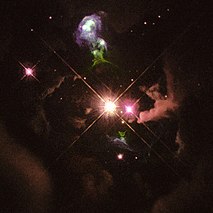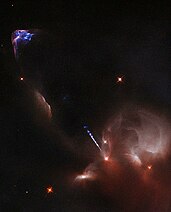Đối tượng Herbig–Haro
| Một phần của loạt bài về |
| Sự hình thành sao |
|---|
 |
| Loại vật thể |
|
| Khái niệm lý thuyết |
|
Đối tượng Herbig-Haro (HH) là các mảng sáng của tinh vân kết hợp với sao mới hình thành. Chúng được hình thành khi các tia hẹp của khí bị ion hóa một phần do các ngôi sao nói va chạm với các đám mây khí và bụi gần đó với tốc độ vài trăm km mỗi giây. Các đối tượng Herbig-Haro có mặt khắp nơi trong các khu vực hình thành sao và một số thường được nhìn thấy xung quanh một ngôi sao duy nhất, thẳng hàng với trục quay của nó. Hầu hết trong số chúng nằm trong khoảng một parsec (3,26 năm ánh sáng) của nguồn, mặc dù một số đã được quan sát thấy một số phân tích. Các vật thể HH là những hiện tượng thoáng qua, chỉ tồn tại khoảng vài chục nghìn năm. Chúng có thể thay đổi rõ rệt trong khoảng thời gian khá ngắn trong vài năm khi chúng di chuyển nhanh chóng khỏi ngôi sao mẹ của chúng vào các đám mây khí của không gian giữa các vì sao (môi trường liên sao hoặc ISM). Các quan sát của Kính viễn vọng Không gian Hubble đã cho thấy sự tiến hóa phức tạp của các vật thể HH trong khoảng thời gian vài năm, khi các phần của tinh vân mờ dần trong khi các phần khác phát sáng khi chúng va chạm với vật chất vón cục của môi trường liên sao.
Lần đầu tiên được Sherburne Wesley Burnham quan sát vào cuối thế kỷ 19, các vật thể Herbig-Haro không được công nhận là một loại tinh vân phát xạ riêng biệt cho đến những năm 1940. Các nhà thiên văn học đầu tiên nghiên cứu chúng một cách chi tiết là George Herbig và Guillermo Haro, và chúng được đặt tên theo tên hai nhà nghiên cứu này. Herbig và Haro đã làm việc độc lập với các nghiên cứu về sự hình thành sao khi họ lần đầu tiên phân tích các vật thể và nhận ra rằng chúng là sản phẩm phụ của quá trình hình thành sao. Mặc dù các vật thể HH là một hiện tượng bước sóng có thể nhìn thấy, nhưng nhiều vật thể vẫn không thể phát hiện được ở các bước sóng này do bụi và khí bao bọc và chỉ có thể nhìn thấy ở bước sóng hồng ngoại. Những vật thể như vậy, khi được quan sát ở vùng hồng ngoại gần, được gọi là Đối tượng đường phát xạ hydrogen phân tử (MHO).
Tham khảo
- ^ Bally, J. (tháng 10 năm 2007). “Jets from young stars”. Astrophysics and Space Science. 311: 15–24. Bibcode:2007Ap&SS.311...15B. doi:10.1007/s10509-007-9531-7.
- ^ Reipurth, B. (tháng 12 năm 2000). “Disintegrating Multiple Systems in Early Stellar Evolution”. Astronomical Journal. 120 (6): 3177–3191. Bibcode:2000AJ....120.3177R. doi:10.1086/316865.
- ^ “Hubble Movies Provide Unprecedented View of Supersonic Jets from Young Stars”. Hubble Space Telescope. European Space Agency. ngày 31 tháng 8 năm 2011. Truy cập ngày 11 tháng 5 năm 2018.
- ^ Herbig, G. H. (1974). “Draft Catalog of Herbig–Haro Objects”. Lick Observatory Bulletin. 658 (658): 1–11. Bibcode:1974LicOB.658....1H.
- ^ Giulbudagian, A. L. (tháng 9 năm 1984). “On a connection between Herbig–Haro objects and flare stars in the neighborhood of the sun”. Astrophysics. 20 (2): 147–149. Bibcode:1984Afz....20..277G. doi:10.1007/BF01005825.
- ^ Andre, P.; Montmerle, T. (tháng 1 năm 1994). “From T Tauri stars to protostars: Circumstellar material and young stellar objects in the rho Ophiuchi cloud”. Astrophysical Journal. 420 (2): 837–862. Bibcode:1994ApJ...420..837A. doi:10.1086/173608.
- ^ McKee, C. F.; Ostriker, E. C. (tháng 9 năm 2007). “Theory of Star Formation”. Annual Review of Astronomy and Astrophysics. 45 (1): 565–687. arXiv:0707.3514. Bibcode:2007ARA&A..45..565M. doi:10.1146/annurev.astro.45.051806.110602.
- ^ Andre, P.; Ward-Thompson, D.; Barsony, M. (tháng 3 năm 1993). “Submillimeter continuum observations of Rho Ophiuchi A: The candidate protostar VLA 1623 and prestellar clumps”. Astrophysical Journal. 406 (1): 122–141. Bibcode:1993ApJ...406..122A. doi:10.1086/172425.
- ^ Stahler, S. W.; Palla, F. (2004). The Formation of Stars. Weinheim: WILEY-VCH Verlag. tr. 321. ISBN 9783527405596.
- ^ Reipurth, B.; Rodrguez, L. F.; Anglada, G.; và đồng nghiệp (tháng 3 năm 2004). “Radio Continuum Jets from Protostellar Objects”. Astronomical Journal. 127 (3): 1736–1746. Bibcode:2004AJ....127.1736R. doi:10.1086/381062.
- ^ “Embedded Outflow in HH 46/47”. NASA Spitzer Space Telescope. Jet Propulsion Laboratory, California Institute of Technology. ngày 18 tháng 12 năm 2003. Truy cập ngày 16 tháng 2 năm 2018.
- ^ Davis, C. J.; Eisloeffel, J. (tháng 8 năm 1995). “Near-infrared imaging in H2 of molecular (CO) outflows from young stars”. Astronomy and Astrophysics. 300: 851–869. Bibcode:1995A&A...300..851D.
- ^ Giannini, T.; McCoey, C.; Nisini, B.; và đồng nghiệp (tháng 12 năm 2006). “Molecular line emission in HH54: a coherent view from near to far infrared”. Astronomy and Astrophysics. 459 (3): 821–835. arXiv:astro-ph/0607375. Bibcode:2006A&A...459..821G. doi:10.1051/0004-6361:20065127.
- ^ Davis, C. J.; Gell, R.; Khanzadyan, T.; và đồng nghiệp (tháng 2 năm 2010). “A general catalogue of molecular hydrogen emission-line objects (MHOs) in outflows from young stars”. Astronomy and Astrophysics. 511: A24. arXiv:0910.5274. Bibcode:2010A&A...511A..24D. doi:10.1051/0004-6361/200913561.
- ^ Smith, M. D.; Khanzadyan, T.; Davis, C. J. (tháng 2 năm 2003). “Anatomy of the Herbig–Haro object HH 7 bow shock”. Monthly Notices of the Royal Astronomical Society. 339 (2): 524–536. Bibcode:2003MNRAS.339..524S. doi:10.1046/j.1365-8711.2003.06195.x.
- ^ Dopita, M. A.; Schwartz, R. D.; Evans, I. (tháng 12 năm 1982). “Herbig–Haro Objects 46 and 47 – Evidence for bipolar ejection from a young star”. Astrophysical Journal Letters. 263: L73–L77. Bibcode:1982ApJ...263L..73D. doi:10.1086/183927.
- ^ Raga, A. C. (2001). “Herbig–Haro Objects and Exciting Stars”. Trong Murdin, Paul (biên tập). Encyclopedia of Astronomy and Astrophysics . Hampshire: Nature Publishing Group. tr. 1654–1657. ISBN 978-0333786536.
- ^ Dyson, J. E.; Franco, J. (2001). “H II Regions”. Trong Murdin, Paul (biên tập). Encyclopedia of Astronomy and Astrophysics . Hampshire: Nature Publishing Group. tr. 1594–1599. ISBN 978-0333786536.
- ^ Reipurth, B.; Heathcote, S.; Morse, J.; và đồng nghiệp (tháng 1 năm 2002). “Hubble Space Telescope Images of the HH 34 Jet and Bow Shock: Structure and Proper Motions”. Astronomical Journal. 123 (1): 362–381. Bibcode:2002AJ....123..362R. doi:10.1086/324738.
- ^ Bacciotti, F.; Eislöffel, J. (tháng 2 năm 1999). “Ionization and density along the beams of Herbig–Haro jets”. Astronomy and Astrophysics. 342: 717–735. Bibcode:1999A&A...342..717B.
- ^ “Infant Star's Artistic Outburst”. Hubble Space Telescope. ESA/Hubble & NASA. ngày 21 tháng 12 năm 2015. Truy cập ngày 16 tháng 2 năm 2018.
- ^ Reipurth, B.; Bally, J. (2001). “Herbig–Haro Flows: Probes of Early Stellar Evolution”. Annual Review of Astronomy and Astrophysics. 39 (1–2): 403–455. Bibcode:2001ARA&A..39..403R. doi:10.1146/annurev.astro.39.1.403.
- ^ Burnham, S. W. (1890). “Note on Hind's Variable Nebula in Taurus”. Monthly Notices of the Royal Astronomical Society. 51 (2): 94–95. Bibcode:1890MNRAS..51...94B. doi:10.1093/mnras/51.2.94.
- ^ Reipurth, B.; Bertout, C. biên tập (1997). “50 Years of Herbig–Haro Research. From discovery to HST”. Herbig–Haro Flows and the Birth of Stars. IAU Symposium No. 182. Dordrecht: Kluwer Academic Publishers. tr. 3–18. Bibcode:1997IAUS..182....3R.
- ^ Carroll, Bradley W.; Ostlie, Dale A. (2014). An Introduction to Modern Astrophysics. Harlow: Pearson Education Limited. tr. 478. ISBN 978-1-292-02293-2.
- ^ Prialnik, D. (2000). An Introduction to the Theory of Stellar Structure and Evolution. Cambridge, United Kingdom: Cambridge University Press. tr. 198–199. ISBN 978-0-521-65937-6.
- ^ Bally, J. (tháng 9 năm 2016). “Protostellar Outflows”. Annual Review of Astronomy and Astrophysics. 54: 491–528. Bibcode:2016ARA&A..54..491B. doi:10.1146/annurev-astro-081915-023341.
- ^ Frank, A.; Ray, T. P.; Cabrit, S.; và đồng nghiệp (2014). “Jets and Outflows from Star to Cloud: Observations Confront Theory”. Trong Beuther, S.; Klessen, R. S.; Dullemond, C. P.; Henning, T. (biên tập). Protostars and Planets VI. Tucson: University of Arizona Press. tr. 451–474. arXiv:1402.3553. Bibcode:2014prpl.conf..451F. doi:10.2458/azu_uapress_9780816531240-ch020. ISBN 9780816531240.
- ^ P. Benvenuti; F. D. Macchetto; E. J. Schreier biên tập (1996). “The Birth of Stars: Herbig–Haro Jets, Accretion and Proto-Planetary Disks”. Science with the Hubble Space Telescope – II. Baltimore: Space Telescope Science Institute. Bibcode:1996swhs.conf..491B. (HTML version)
- ^ Dopita, M. (tháng 2 năm 1978). “The Herbig–Haro objects in the GUM Nebula”. Astronomy and Astrophysics. 63 (1–2): 237–241. Bibcode:1978A&A....63..237D.
- ^ Bally, J.; Reipurth, B.; Davis, C. J. (2007). “Observations of Jets and Outflows from Young Stars” (PDF). Trong Reipurth, B.; Jewitt, D.; Keil, K. (biên tập). Protostars and Planets V. Tucson: University of Arizona Press. tr. 215–230. Bibcode:2007prpl.conf..215B.
- ^ Schwartz, R. D. (1983). “Herbig–Haro Objects”. Annual Review of Astronomy and Astrophysics. 21: 209–237. Bibcode:1983ARA&A..21..209S. doi:10.1146/annurev.aa.21.090183.001233.
- ^ Heathcote, S.; Reipurth, B.; Raga, A. C. (tháng 7 năm 1998). “Structure, Excitation, and Kinematics of the Luminous Herbig–Haro Objects 80/81”. Astronomical Journal. 116 (4): 1940–1960. Bibcode:1998AJ....116.1940H. doi:10.1086/300548.
- ^ Hartigan, P.; Morse, J.; Reipurth, B.; và đồng nghiệp (tháng 9 năm 2001). “Proper Motions of the HH 111 Jet Observed with the Hubble Space Telescope”. Astrophysical Journal Letters. 559 (2): L157–L161. Bibcode:2001ApJ...559L.157H. doi:10.1086/323976.
- ^ Raga, A.; Reipurth, B.; Velázquez, P.; và đồng nghiệp (tháng 12 năm 2016). “The time evolution of HH 2 from four epochs of HST images”. Astronomical Journal. 152 (6): 186. arXiv:1610.01951. Bibcode:2016AJ....152..186R. doi:10.3847/0004-6256/152/6/186. 186.
- ^ Zealey, W. J. (1992). “Young Stellar Objects and Herbig–Haro Objects”. Australian Journal of Physics. 45 (4): 487–499. Bibcode:1992AuJPh..45..487Z. doi:10.1071/PH920487.
- ^ Raga, A.; Cantó, J. (tháng 10 năm 2017). “The formation of double working surfaces in periodically variable jets”. Revista Mexicana de Astronomía y Astrofísica. 53 (2): 219–225. Bibcode:2017RMxAA..53..219R.
- ^ Brugel, E. W.; Boehm, K. H.; Mannery, E. (1981). “Emission line spectra of Herbig–Haro objects”. Astrophysical Journal Supplement Series. 47: 117–138. Bibcode:1981ApJS...47..117B. doi:10.1086/190754.
- ^ Hartigan, P.; Morse, J. A.; Raymond, J. (tháng 11 năm 1994). “Mass-loss rates, ionization fractions, shock velocities, and magnetic fields of stellar jets”. Astrophysical Journal. 436 (1): 125–143. Bibcode:1994ApJ...436..125H. doi:10.1086/174887.
- ^ "Infant Star's Artistic Outburst". Hubble Space Telescope. ESA/Hubble & NASA. ngày 21 tháng 12 năm 2015. Truy cập February 16, 2018.

